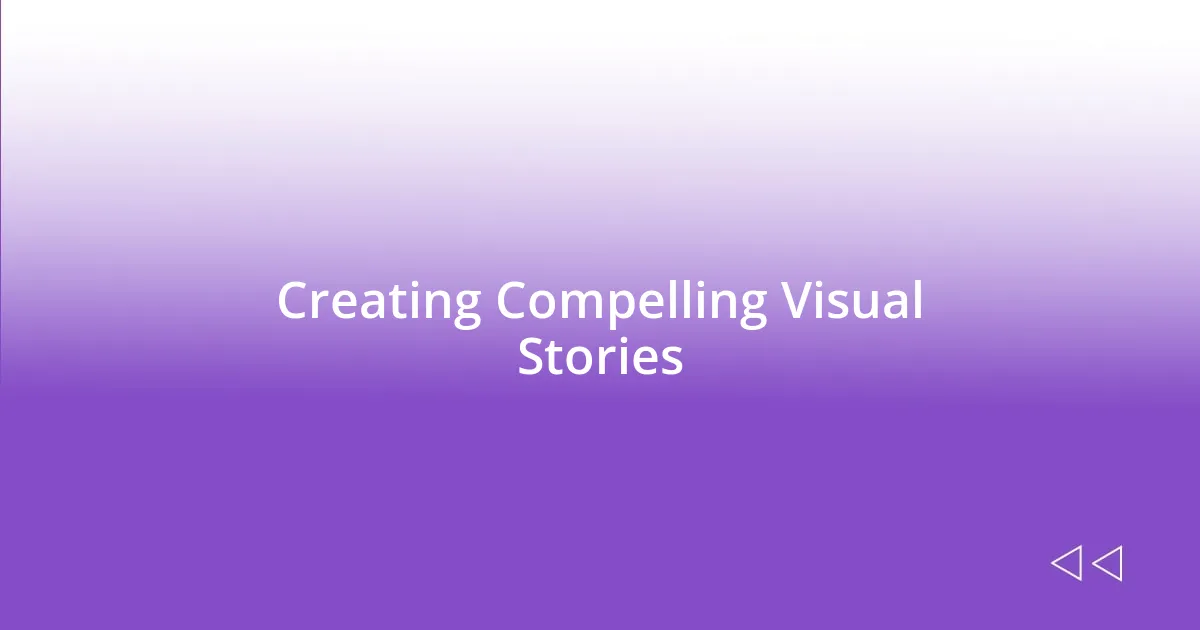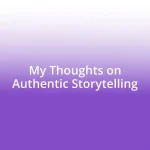Key takeaways:
- Visual narratives enhance communication by simplifying complex ideas and evoking emotional connections.
- Choosing the right visual tools (like Canva or infographic makers) significantly improves audience engagement and message effectiveness.
- Incorporating storytelling and visuals can create compelling narratives that foster collaboration and connection among participants.
- Evaluating the emotional impact of visuals is crucial, as they can profoundly influence audience perception and engagement.

Understanding Visual Narratives Importance
Visual narratives hold significant power in communication, and I’ve seen their impact firsthand. It’s fascinating how a single image can convey complex emotions or stories that words sometimes struggle to express. When I stumbled across a photo that encapsulated both joy and despair in one frame, I realized how visuals can resonate on a deeper emotional level, ensuring that the audience feels something profound.
In my daily interactions, I often use visual narratives to simplify complex ideas. For instance, when presenting to a client, I combine charts with visuals that illustrate data trends. It’s surprising how much clarity an infographic can bring—suddenly, numbers transform into a compelling story. Have you ever noticed how your eyes glaze over during a purely text-heavy presentation? The inclusion of visuals captivates attention and makes the information sticky, which is crucial when you want your audience to remember key points.
Moreover, I believe that visuals can foster connections among diverse audiences. I recall a workshop where participants shared their personal experiences through collages. This not only enhanced understanding but created empathy among us. How often do we connect with others’ stories when they are presented visually? This is why I see visual narratives not just as tools, but as vital bridges that enhance communication and foster human connection.

Daily Applications of Visual Narratives
Visual narratives are woven into my daily routine in ways that might surprise you. For instance, I often turn to social media platforms to share moments of my day. A simple yet poignant image of my morning coffee beside an open notebook can convey a sense of calm and inspiration that words alone might fail to capture. It’s in these small moments that I see how powerful visuals can evoke a shared experience among friends and followers.
- I create mood boards to inspire my creative projects.
- I utilize video snippets to summarize my thoughts on complex subjects.
- I design visual timelines for project planning, bringing clarity to our team’s goals.
- I capture behind-the-scenes photos to share the journey of my work, fostering a sense of community.
Each of these practices reminds me that visual narratives can transcend language barriers, making it easier for others to connect with my thoughts and aspirations.

Choosing the Right Visual Tools
Choosing the right visual tools can dramatically change how I communicate my ideas. I’ve discovered that the medium is just as important as the message. For example, when crafting a presentation, I’ve found that software like Canva resonates better with audiences than traditional PowerPoint slides. It’s amazing how vibrant colors and unique layouts can elevate the perceived value of my content. Do you ever feel more engaged when visuals are fresh and creative?
In my experience, comparing various tools helps me select what suits my needs best. Take infographic makers versus simple image editing apps—each serves a different purpose. Infographics allow me to present densely packed data in a visually appealing format, while editing tools let me enhance photos for blog posts. When I used an infographic to summarize my team’s quarterly performance, the response was overwhelmingly positive; people appreciated the clarity and attractiveness of the presentation. Did you ever notice how people react differently to stark data versus engaging visuals?
Here’s a little comparison that I found helpful when selecting visual tools based on my experiences:
| Visual Tool | Purpose |
|---|---|
| Canva | Create vibrant presentations |
| Infographic Makers | Stylishly present complex data |
| Photo Editing Apps | Enhance images for social sharing |
| Video Editing Software | Craft engaging narratives through motion |

Creating Compelling Visual Stories
Creating compelling visual stories is all about understanding how each element contributes to the narrative. I remember a time when I was preparing for an art show, and instead of focusing solely on the artwork, I decided to document the process. By snapping photos of my workspace, my sketches, and even the paint splatters on my hands, I created a visual timeline that invited viewers into my creative journey. Doesn’t it feel like you’re part of the story when you get those behind-the-scenes glimpses?
Another approach I take is using contrasting visuals to highlight different emotions. For instance, during a particularly challenging week, I captured both joyful moments with friends and the quieter, more introspective times alone. The contrast between laughter and solitude told a rich story about life’s ups and downs. It made me wonder: how often do we overlook the power of juxtaposition in our narratives? By embracing both sides, I found a deeper connection with my audience.
I’ve also experimented with layering visuals, which adds depth to my storytelling. Once, I created a photo collage that intertwined snapshots of nature with quotes from my favorite authors. The combination sparked conversations among friends about both art and literature. It’s amazing how visuals can create a tapestry that draws people in, isn’t it? In my experience, this technique not only captivates but also opens the door for meaningful dialogue. Each layer tells its own story while contributing to a larger narrative, making the experience all the more enriching for everyone involved.

Integrating Visuals into Communication
Integrating visuals into communication can transform how ideas are conveyed. I vividly recall a meeting where I used a simple storyboard technique to outline a new project proposal. Instead of drowning my colleagues in bullet points, I illustrated the entire timeline with hand-drawn sketches. Their engagement shifted instantly; they were not just listening but visually following along. Have you ever noticed how a well-placed image can clarify confusion in a conversation?
In my daily communications, I’ve embraced the power of visualization by infusing graphs and charts into reports. For instance, during a recent team review, I paired a pie chart with a brief narrative to summarize our budget allocations. This combination not only made the numbers more digestible but also sparked a healthy discussion about our priorities. It was fascinating to see how visual representation could invite questions and insights—do you think it encourages others to share their thoughts more openly?
I’ve also discovered the impact of using visual metaphors. When discussing personal growth in a workshop, I brought a small plant to symbolize nurturing skills. Watching participants draw parallels between the plant’s growth and their own progress was enlightening. It reminded me that visuals can evoke emotions and memories, fostering connections. Have you experienced a moment where a simple visual changed the way you perceived a concept? I believe that integrating visuals this way allows for a richer, more relatable conversation.

Evaluating the Impact of Visuals
Evaluating the impact of visuals is something I constantly reflect on in my daily practice. I recall the time I shared a visual infographic in a community presentation about local environmental initiatives. The moment I watched the audience connect with colorful images and concise data, I realized how visuals could distill complex information into something easily digestible. Have you ever seen how a picture can evoke feelings even before the words do?
In my experience, I’ve found that the emotional resonance of visuals can significantly influence audience perception. For example, when I used a series of black-and-white photographs to convey the struggles of homelessness, the stark imagery sparked an empathetic response from viewers. It’s fascinating to consider: how do certain visuals resonate with our deepest emotions while others fall flat? I believe the key lies in the context and authenticity of the visuals being used.
Additionally, I often assess how visuals enhance or detract from the message I’m trying to convey. A while back, I created a presentation that included both vibrant images and more muted tones to signify various stages of a project. The feedback was illuminating; my audience felt energized during the positive segments but more contemplative during the challenges. Does this mean that visuals not only serve as illustrations but also guide emotional experiences? I think that’s a profound realization and an essential aspect of effective storytelling.

Enhancing Engagement with Visual Techniques
Using visuals to boost engagement can be a game-changer in communication. I remember a workshop where I decided to ditch the slides and replace them with a live drawing of the discussion points. As I sketched, the group’s involvement intensified; participants leaned in and started to contribute their ideas freely. Have you ever experienced that moment of collective energy where everyone just clicks together? It’s mesmerizing, right?
I often think about the role colors play in my visual narratives. During a brainstorming session, I used a color-coded mind map to outline our ideas, and as I introduced each color, I noticed certain faces lighting up. The vibrant hues seemed to ignite creativity, pushing team members to think outside the box. I wonder—do colors create emotional hooks in your experiences? For me, they often set the tone and mood, transforming a mundane meeting into a lively exchange.
Another technique I find invaluable is incorporating storytelling into visuals. Once, I created a timeline graphic for a project that was filled with personal anecdotes from my team. As we discussed each phase, the laughter and shared memories unfolded, fostering a bond among us. How powerful is it to see your story laid out visually? It reminds me that visuals do more than provide information; they bring our experiences to life, creating connections that resonate long after the discussion ends.














